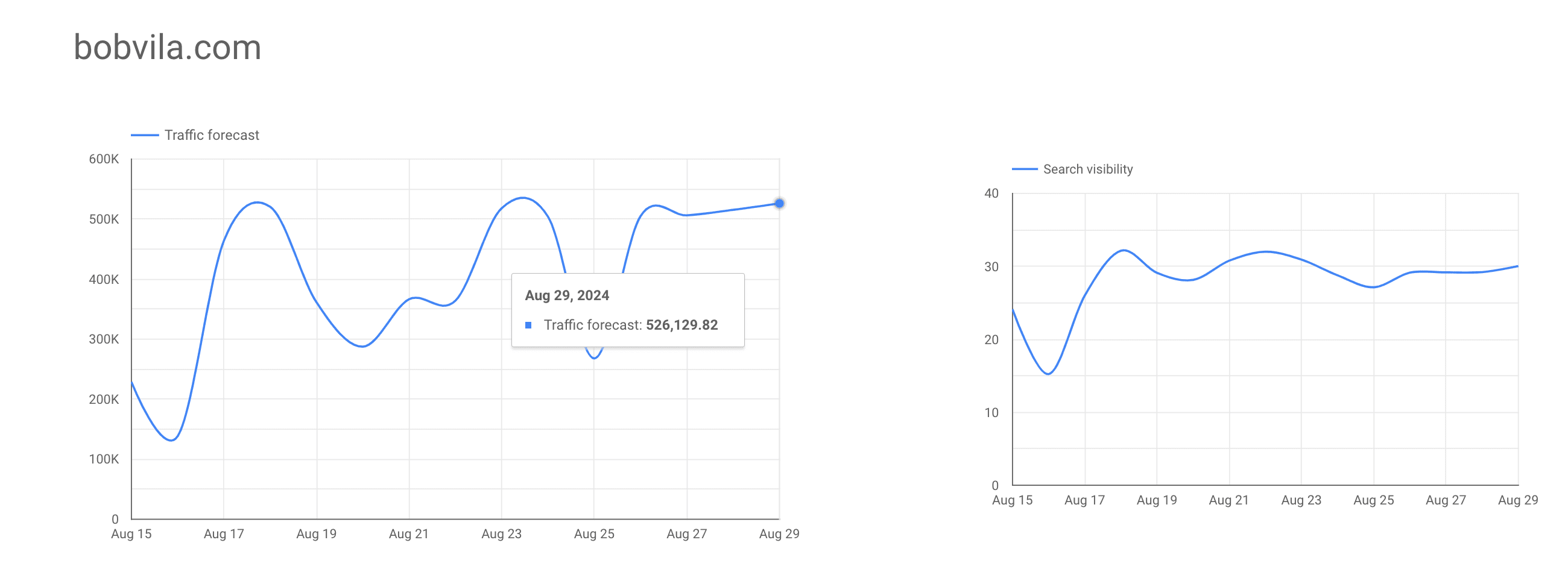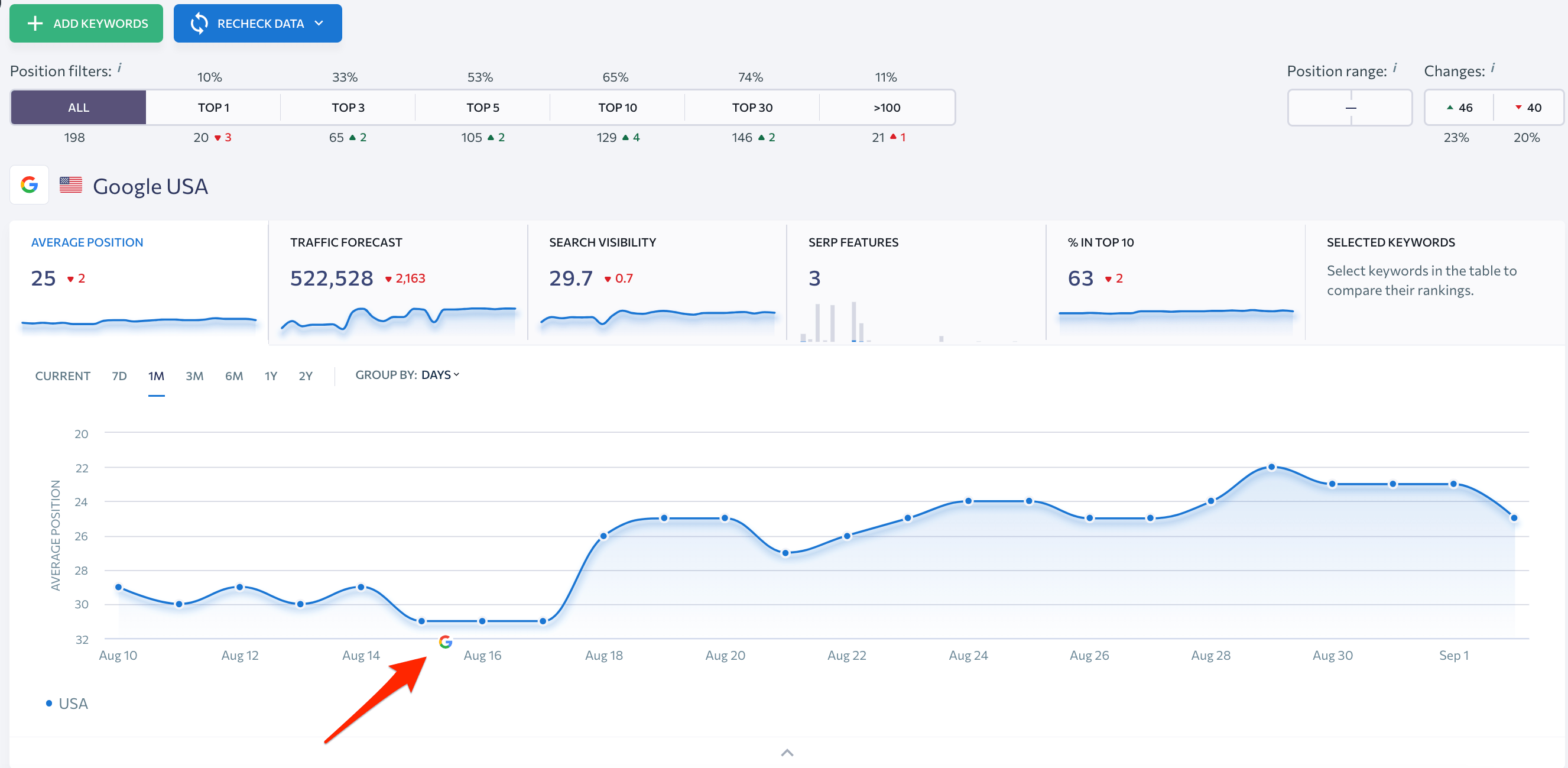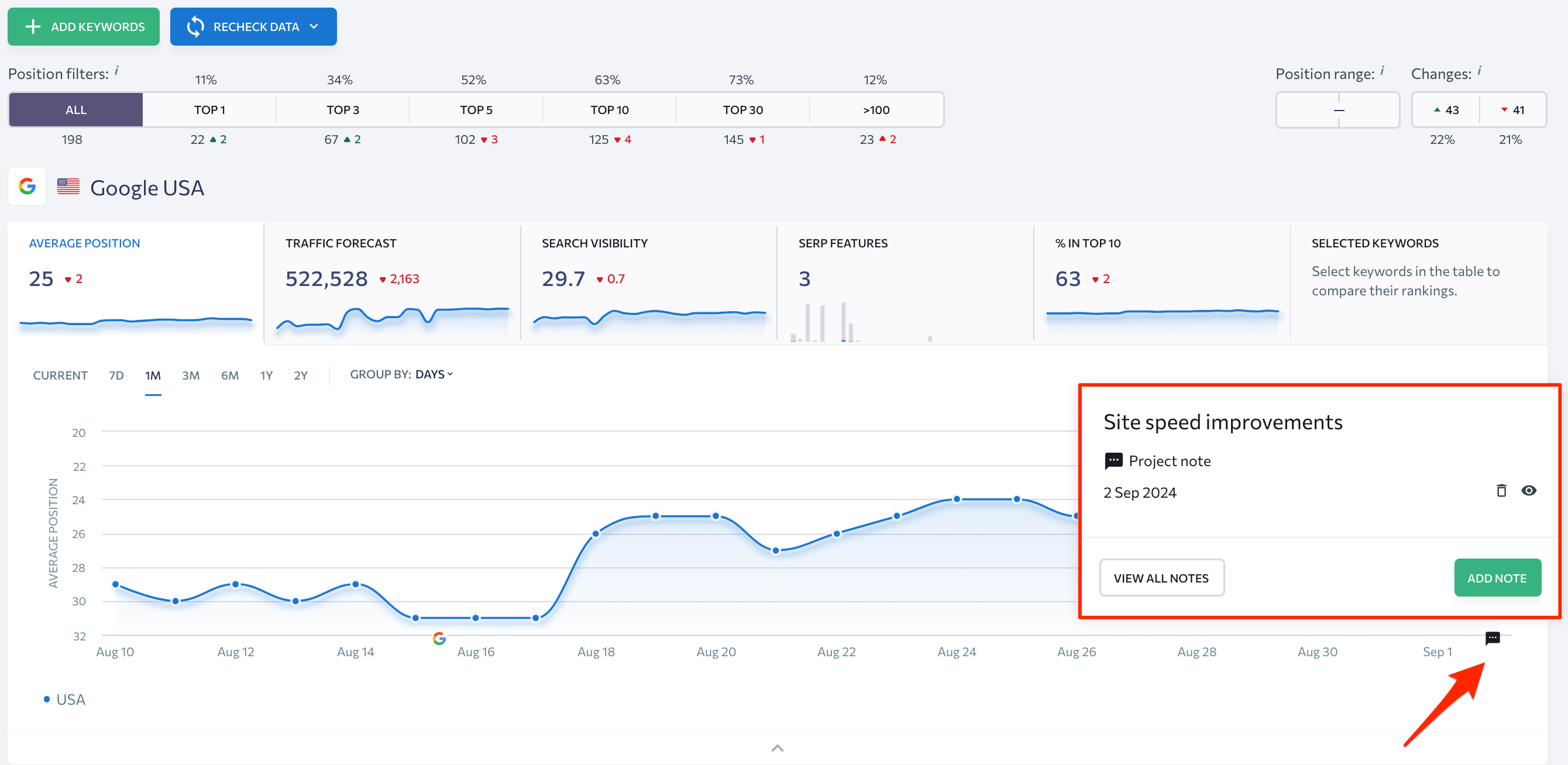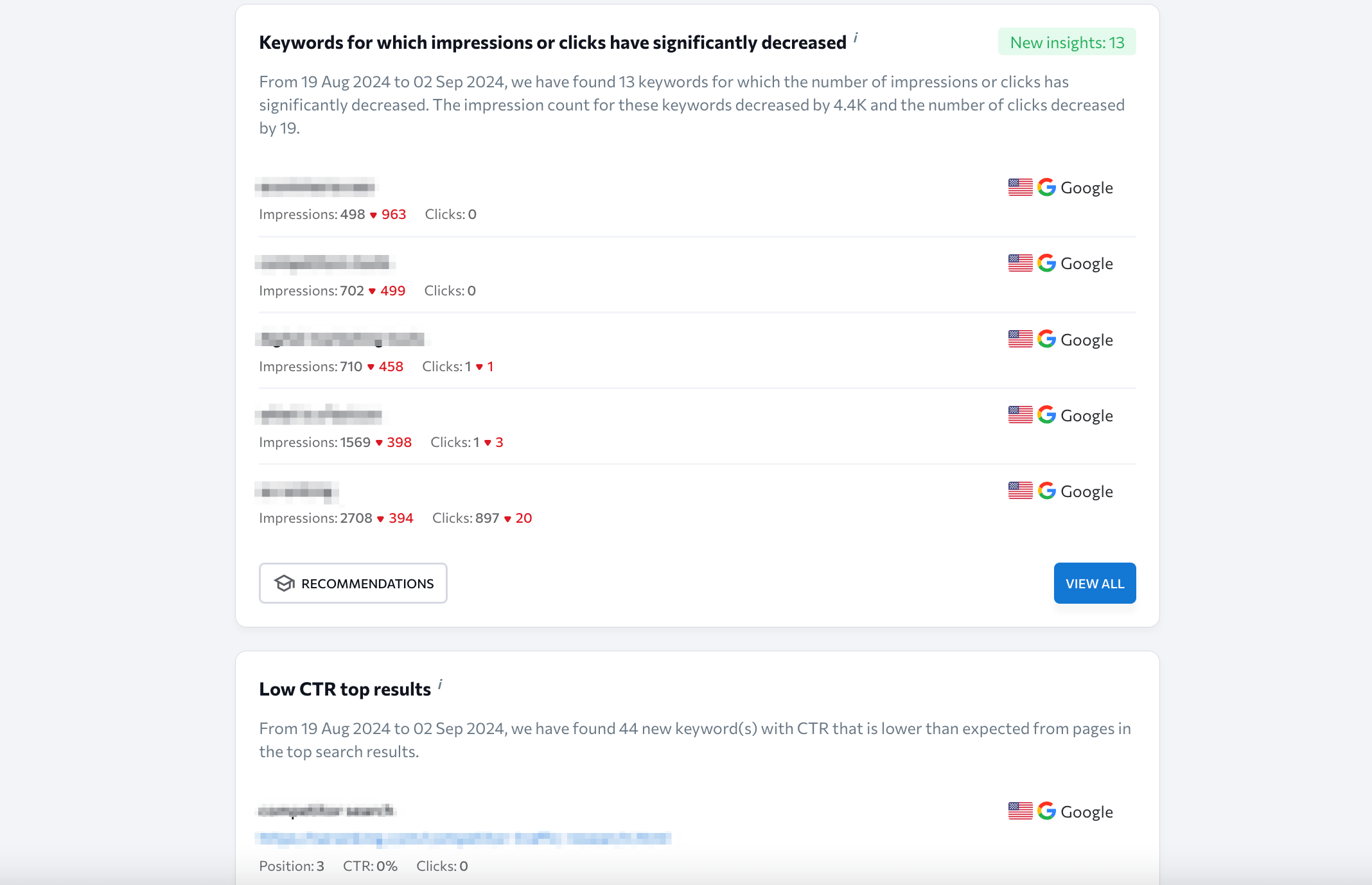
-
On September 14, 2023, Google announced the HCU with the improved classifier. This update aimed to prioritize helpful, relevant content and improve overall page experience as ranking factors.
-
Starting from the first days of the update rollout, many websites saw significant traffic and ranking drops. The situation didn’t stabilize even after the update rollout ended.
-
The March Core Update integrated HCU into the overall ranking system. There were hopes of improvement for HCU-impacted sites with this update, but it didn’t happen. The ongoing challenge of websites struggling to recover from HCU persisted until August.
-
In August, Google announced a new core update was coming. Google hosted several creator meetings during the update’s preparation, which gave many people hope that it would be more responsive to their needs.
-
The August Core Update is showing early signs of recovery for some websites impacted by the Helpful Content Update, with improved traffic and rankings.
-
Google announced the completion of its August Core Update on September 3. While most sites affected by the HCU saw major improvements, many are still only recovering 10-20% of their previous performance from a year ago.
Since Google’s Helpful Content Update (HCU) was introduced in September 2023, many websites have experienced notable declines in rankings and traffic. However, after almost a year of disappointment and growing frustration within the SEO community, there are signs of recovery. Some of these affected sites are starting to bounce back.
Let’s walk through the key events following the HCU update and look at some promising signs of recovery among impacted sites.
Major Events Timeline
September 2023: HCU Rollout
This is when everything began.
On September 14, Google rolled out the HCU, continuing its efforts to refine the way content is ranked on SERPs. This update has come with an “improved classifier”.
Here’s a brief summary of key aspects that have changed with this update:
1. Google revised its guidance, which initially required content to be “written by people.” This change supposedly indicates a shift toward prioritizing content quality, relevance, and helpfulness over a strict stance against AI-generated content.
2. The update targeted sites hosting third-party content, particularly on subdomains. If this content was independent of the main site’s purpose or poorly supervised, it risked negatively impacting the site’s overall ranking.
3. Google clarified in its self-assessment guidance that merely changing publish dates or adding/removing content won’t improve rankings. Only genuine, value-adding updates are necessary to enhance content freshness.
4. The update placed greater emphasis on overall page experience as a ranking factor. Key elements like ease of navigation, mobile-friendliness, and the absence of intrusive ads became critical for maintaining or improving rankings.
Many website owners and SEO pros noticed significant traffic & ranking fluctuations since the first days of the update rollout. Here are some comments on forums as of September 2023:
- “In fact so far today I have had only 15% of my average traffic, yes 15%.”
- “USA traffic -62% at 1pm on Sunday…Canada is -40% and Australia is -30%. USA was also down most of the day yesterday, but ended up +4% after a late ***** spike.”
- “I’ve got long-form content, well written, well researched, filled with original image content LOSING to 500 word AI-generated piece.”
Most people were hoping during this time that the situation would stabilize within a couple of weeks, as had often been the case with previous Google updates.
October 2023 – February 2024: Monitoring and Analysis
During this period, the focus remained on understanding the update’s nuances and how to address the challenges it created.
Unfortunately, “fixing” these fluctuations wouldn’t be that easy. Many sites continued to struggle, and there was a general sense of pessimism.
Many were worried about the time it might take to recover. To answer this question, Danny Sullivan (Google’s Search Liaison) explained how the helpful content classifier works:
In fact, he repeated the following claim made by Google about how the helpful content system operates: “The algorithm is constantly looking at your content and assigning scores to it.”
In other words, search rankings could improve at anytime. This could occur even prior to the classifier’s next update. But during that time, no site had fully recovered from the HCU.
Some website owners were so desperate that they even abandoned their old websites and launched brand new ones in the hope to regain SERP positions and traffic. For instance, here’s what one forum user wrote:
“This February, I started a brand new site (brand new domain) and took the previously written but unused content for the old site and moved it to the new one. The result? It’s ranking higher than the original site on the back of very little backlinks, and it’s also outranking other more popular sites in the niche.”
However, it’s possible that this new site only performed well because it was fresh. It hadn’t yet been affected by classifiers. It’s uncertain what will happen to the site after the next update. But what we can say for sure is that continuously launching new sites as a recovery strategy is not the best approach.
March 2024 – July 2024: HCU Becomes Part of the Core System
On March 5, 2024, Google launched the March 2024 core update. This update marked the integration of HCU into the core ranking system, meaning there would no longer be separate updates for helpful content. Elizabeth Tucker, Director of Product at Google Search, confirmed this to Barry Schwartz:
“So yeah, the helpful content system is now part of the core ranking system; no more updates on that going forward.” Schwartz later added that “those impacted by the March 2024 core update will not receive manual actions”
This is what Google said regarding this update:
“This update involves refining some of our core ranking systems to help us better understand if webpages are unhelpful, have a poor user experience, or feel like they were created for search engines instead of people.”
Plus, they added that “you’ll now see 45% less low-quality, unoriginal content in search results.”
The hope was that this core update might improve the performance of sites negatively impacted by the September 2023 HCU.
As of March 29, Glenn Gabe (who has been tracking hundreds of sites hit by both the helpful content update and the core updates) posted on X that some websites affected by previous core updates have started recovering:
Yet, on March 31, Glenn Gabe posted on X that those affected by the HCU showed no signs of improvement.
On April 1, John Mueller shared interesting insights about this update:
So, the March Core Update was operating based on a complete re-evaluation of websites, not a simple comparison to their past performance. This meant that websites would be judged and analyzed under a new benchmark, one that considers current user expectations and the broader online environment.
This sparked optimism among SEO professionals, who were hopeful that it would reverse the decline in their rankings that began in September 2023.
There was great anticipation throughout the entire 45-day update period, culminating on April 19th. Unfortunately, the improvements the community hoped for did not occur.
The performance of the affected sites remained unchanged, leaving site owners disheartened because:
- Many felt they had been unfairly affected.
- Their efforts to address the issues were in vain, leading to dejected feelings.
This situation persisted until July, when Google announced the upcoming core update. Here is what Danny Sullivan said:
“I would expect we’ll see one [update] in the coming weeks, because that fits in with our general cycle. But precisely when, that’s just not known yet.”
When Google revealed that they had hosted several creator meetings during the update’s preparation to gain better insights into their challenges and experiences, it gave many people hope that the upcoming update would be more responsive to their needs.
August 2024: HCU Recovery Signs
On August 15, Google released the August 2024 Core Update. Some websites negatively affected by the HCU began to show signs of recovery from the very first days of the update rollout.
On August 16, Glenn Gabe posted the first edition of the so-called “Core Update Notes.” Based on his observations, some websites affected by HCU have finally begun to recover.
As of August 28, Glenn Gabe reports that 81 out of the 390+ websites he tracks have recovered to some extent:
James Brockbank, SEO expert and agency owner, has also noticed this pattern in the travel niche. He’s seen a 50% traffic increase on 46 websites out of 671 affected by the HCU:
Lily Ray, in turn, noticed a “speed recovery” for one HCU website. She also noticed another website with an 80% recovery compared to its September 2023 levels:
Our own observations also confirm signs of HCU recovery for some websites. For instance, within just two weeks of the update rolling out, bobvilla.com has managed to increase its estimated traffic by more than two times—from 228k to 526k. Its search visibility has also greatly increased.

These findings clearly indicate that affected sites are starting to see improvements in their rankings and traffic. Recovery from the HCU is possible, though it may take some time.
Meanwhile, the Core Updates document on Google Search Central has slightly expanded:
1. Google suggests that if your website’s overall ranking has significantly and consistently declined, you should review the self-assessment guide. This guide helps determine if your site’s content is valuable, trustworthy, and user-focused. Notably, Google mentioned this guide three times in one section (likely emphasizing its importance for improving your site’s ranking).
2. Google added a section on what to keep in mind when making changes:
- Don’t make quick changes just because someone said it’s good or bad for SEO.
- Enhance your content in ways that genuinely benefit your audience, like rewriting or adding new sections.
- Deleting content should be a last resort. If you’re deleting something, it’s a sign those sections were created for search engines first (rather than users).
- Some changes may show results within days, while others might take months; if results are still lacking, wait for the next update.
The rollout of this update was initially expected to take around a month. But on September 3, Google confirmed that the August 2023 Core Update, the second major update of the year, has finished its rollout.
While some website owners and SEO pros have already reported a significant improvement in rankings and traffic, it’s too early to make any definite conclusions.
Based on available data, only a handful of websites have fully recovered their pre-HCU performance, while the majority have seen only modest progress. Many sites remain significantly below previous levels, with some having recovered just 10-20% of their traffic from the same period last year.
Although we can conclude that there are initial indications of HCU recovery, we need more time to gauge if these improvements will be sustained across more sites over the coming months.
How to Monitor HCU Recovery
Tracking your and your competitors’s rankings and traffic is an integral part of any SEO strategy. But with Google updates, this becomes even more important. Why? Because during these updates, rankings and traffic tend to fluctuate pretty quick. Closely watching these changes gives you a better understanding of the impact so you can plan your next steps beyond the update’s completion.
For instance, with SE Ranking’s Position Tracker, you can get precise daily ranking updates and monitor changes in search visibility and traffic. What’s convenient is that the tool automatically places labels of Google updates on a timeline graph. This makes it easy to see correlations between your ranking dynamics and new Google algorithms.

Plus, you can leave your custom notes on the graph to track the relationship between your optimization efforts and ranking changes.

Also, our Insights tool reveals non-obvious insights on major performance changes, be it yours or your competitors’. For example, you can gain high-value data on newcomers among competitors in the top 10, as well as keywords and pages for which impressions or clicks have significantly increased/decreased.

To Wrap Up
With the new August Core Update, it seems that a long-awaited HCU recovery is finally possible. But although the update rollout is complete, websites may still need more time to see the full benefits. Google’s algorithms are complex, and it often takes several weeks or even months for significant changes to take effect.
For now, we’ll continue to monitor the situation closely. Hopefully, Google will acknowledge and reward websites that truly serve the needs of their audience.



